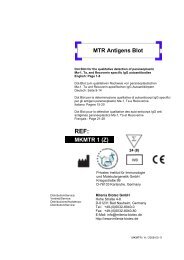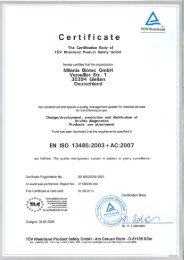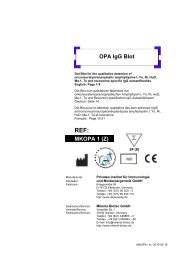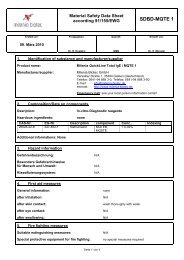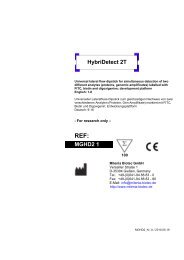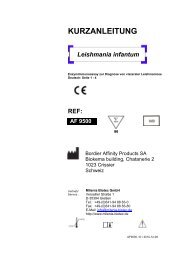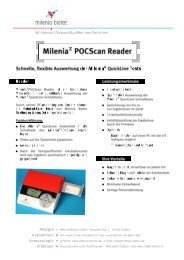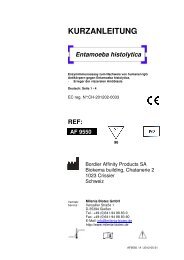Arbeitsanleitung - Milenia Biotec GmbH
Arbeitsanleitung - Milenia Biotec GmbH
Arbeitsanleitung - Milenia Biotec GmbH
Sie wollen auch ein ePaper? Erhöhen Sie die Reichweite Ihrer Titel.
YUMPU macht aus Druck-PDFs automatisch weboptimierte ePaper, die Google liebt.
CRP<br />
Lateral Flow Immunoassay for semi quantitative measurement<br />
of human C-reactive protein (CRP) in whole blood and serum;<br />
interpretation by the <strong>Milenia</strong> ® POCScan Reader<br />
English: Page 1-6<br />
Lateralfluss-Immunoassay zur semiquantitativen<br />
Bestimmung von humanem C-reaktivem Protein (CRP)<br />
in Vollblut und Serum;<br />
Auswertung mit dem <strong>Milenia</strong> ® POCScan Reader<br />
Deutsch: Seite 7-12<br />
REF:<br />
MQLRP 1<br />
30<br />
<strong>Milenia</strong> <strong>Biotec</strong> <strong>GmbH</strong><br />
Versailler Str. 1<br />
D-35394 Gießen<br />
Germany<br />
Tel.: +49-641-94 8883-0<br />
Fax: +49-641-94 8883-80<br />
E-mail: info@milenia-biotec.de<br />
http://www.milenia-biotec.de<br />
MQLRP / B / 2012-06-20
- 2 -<br />
Explanation of Symbols<br />
Symbols (E)<br />
Symbole (D)<br />
Explanation<br />
Erklärung<br />
Symbols (E)<br />
Symbole (D)<br />
Explanation<br />
Erklärung<br />
Use by<br />
Verwendbar bis<br />
Contains sufficient for<br />
Inhalt ausreichend für<br />
In vitro diagnostic medical device<br />
In-vitro Diagnostika<br />
Manufacturer<br />
Hersteller<br />
Batch code<br />
Chargenbezeichnung<br />
For IVD performance<br />
evaluation only<br />
Nur zur IVD<br />
Leistungsbewertung<br />
REF<br />
Catalogue number<br />
Katalognummer<br />
Consult Instructions for<br />
use<br />
Gebrauchsanweisung<br />
beachten<br />
Storage conditions<br />
Lagerungsbedingungen<br />
Consult attended<br />
documents<br />
Begleitdokumente<br />
beachten<br />
<strong>Milenia</strong> <strong>Biotec</strong>, Versailler Straße 1, D-35394 Gießen<br />
<strong>Milenia</strong> QuickLine CRP (MQLRP)
- 3 -<br />
Materials Provided,- Storage and Stability<br />
Preparation Storage at Shelf life<br />
Components Cat.-No. Content<br />
CRP Test Unit:<br />
MQSRP<br />
s<br />
30 ready to use 2 - 8 °C<br />
membrane coated with<br />
Use<br />
monoclonal (mouse) anti-hCRP<br />
immediately<br />
antibody; monoclonal (mouse)<br />
after opening<br />
anti-hCRP antibody conjugated<br />
the foil pouch!<br />
to gold particles<br />
CRP/ hsCRP Chase Buffer:<br />
PBS-Buffer, pH 7.4<br />
This bag contains<br />
30 Transfer pipettes<br />
10 µL, disposables<br />
Certificate of Analysis<br />
MQCBC<br />
1 vial<br />
with 3 ml<br />
(yellow<br />
cap)<br />
in the closed<br />
foil pouch until<br />
expiration date<br />
ready to use 2 - 8 °C until expiration<br />
date<br />
MQP1030 30 see procedure p.5 until expiration<br />
date<br />
CoA-<br />
MQLRP<br />
Material Safety Data Sheets are available on request (look as well www.milenia-biotec.de).<br />
Intended Use<br />
1<br />
• For in vitro diagnostic use.<br />
• <strong>Milenia</strong> ® QuickLine CPR is designed for semi quantitative measurement of human CRP in whole blood and<br />
serum<br />
Materials Required But Not Supplied<br />
Pipet and tips: 5 µL (serum samples)<br />
Specimen Collection and Preparation<br />
Whole blood: capillary blood, venous blood, or serum.<br />
Avoid hemolysis; separate serum from blood cells within two hours.<br />
Whole Blood: avoid blood from clotting e.g with anticoagulants like heparin, EDTA; no citrate.<br />
Volume Required<br />
Whole blood: 10 µL<br />
Serum: 5 µL<br />
Warnings and Precautions<br />
• Read these instructions and the <strong>Milenia</strong> ® POCScan Reader Manual carefully before performing the<br />
test. Follow them step by step!<br />
• Store reagents at 2 - 8° C!<br />
• Do not use the kit after expiration date!<br />
• Do not use test unit if foil pouche is damaged!<br />
• Protect test units from moisture!<br />
• Compare batch code of your kit and the given batch code in your reader; if necessary: change batch<br />
code and parameters. (s. <strong>Milenia</strong> ® POCScan Reader Manual –‘Enter Test Parameters’)<br />
• Do not interchange components of packages of different batch codes!<br />
• All samples, used units, pipettes, tips, and other contaminated material should be handled carefully<br />
and as potentially infectious.<br />
• For professional users.<br />
<strong>Milenia</strong> <strong>Biotec</strong>, Versailler Straße 1, D-35394 Gießen<br />
<strong>Milenia</strong> QuickLine CRP (MQLRP)
- 4 -<br />
Summary and Explanation<br />
Being an acute phase protein, C-reaktive protein (CRP) is mainly synthesized in the liver. However, recent<br />
research has shown that the inflammatory protein is also produced in other tissues such as vascular smooth<br />
muscle cells and adipocytes. The expression of CRP is particularly increased in pathologically altered vessels.<br />
The CRP serum level was originally determined to detect and monitor acute inflammation. The value may<br />
increase up to 1000fold under acute inflammatory conditions.<br />
Method and Test Principle<br />
The <strong>Milenia</strong> ® QuickLine CRP test is a lateral flow immunoassay designed for semi quantitative measurement<br />
of human CRP in capillary blood, venous blood, or serum.<br />
The sample is pipetted into the sample application port.<br />
The CRP in patients’ sample binds first to a monoclonal anti-CRP antibody that is conjugated to gold particles.<br />
The CRP-loaded gold particles diffuse through the membrane and pass Test line T. There, a monoclonal CRP<br />
specific antibody is coated on the membrane. At this place the CRP-gold-particels were bound specifically and<br />
become visible as Test line T. The color intensity of the Test line is directly proportional to the concentration of<br />
CRP in the sample. The intensity increases during incubation time. Excess gold conjugate diffuses further over<br />
the test membran. Conjugat-specific antibodies that applied onto the membrane are functioning as Control line<br />
(C). Here the residual gold conjugate is captured and forms a well visible line during the incubation time.<br />
Increasing or decreasing colour’s intensity of the Control line can not be used for any interpretation.<br />
The test unit must be evaluated colourimetrically with the <strong>Milenia</strong> ® POCScan Reader.<br />
The result displayed on the reader is calculated according to a stored standard curve.<br />
<strong>Milenia</strong> <strong>Biotec</strong>, Versailler Straße 1, D-35394 Gießen<br />
<strong>Milenia</strong> QuickLine CRP (MQLRP)
- 5 -<br />
Test Procedure<br />
Preparation:<br />
Allow test unit and chase buffer to come to room temperature (18 – 28 °C) before opening!<br />
Never store test units at room temperature! Use test units immediately after opening!<br />
Compare batch code on the outerbox label and given batch code at <strong>Milenia</strong> ® POCScan Reader if<br />
necessary enter new batch code and parameters. (see <strong>Milenia</strong> ® POCScan Reader Manual, p. 12/13)<br />
Consult attended documents: Certificat of Analysis (CoA-MQLRP) - batch code specific.<br />
Capillary blood collection:<br />
a) Hold transfer pipet horizontally into the blood drop without pushing the bulb.<br />
The blood is filled in automatically by capillarity-up to the black mark, equivalent to 10 µL.<br />
b) To apply the sample into the sample application port of the test unit squeeze pipet’s bulb to empty<br />
it. Do this in a timely manner but not too fast.<br />
Avoid blood clotting or air bubbles. (Risk of false results)<br />
Steps<br />
1.<br />
Pipet 10 µL whole blood or 5 µL serum into the sample application port<br />
of the test unit.<br />
2.<br />
Add 2 drops chase buffer<br />
Note: Do not contaminat the vial with sample material!<br />
3.<br />
4.<br />
Incubation<br />
10 minutes at room temperature (18 - 28 °C)<br />
Put test unit in the drawer.<br />
Close drawer!<br />
Start<br />
SCAN<br />
- Mode, SCAN IN PROGRESS:<br />
<br />
<br />
Scan<br />
Result calculation<br />
5. Result is displayed.<br />
Scan Mode<br />
CRP: 10 - 20 mg/l<br />
Next test Delete Print<br />
If result is INVALID check described items on flyer:<br />
“Notice INVALID/ A / 2009-10-16<br />
For enquiries or error messages, please contact your local distributor or<br />
Customer Service at <strong>Milenia</strong> <strong>Biotec</strong> <strong>GmbH</strong>.<br />
E mail: cwillsch@milenia-biotec.de<br />
The <strong>Milenia</strong> ® POCScan Reader manual can be downloaded from the<br />
website www.milenia-biotec.de<br />
<strong>Milenia</strong> <strong>Biotec</strong>, Versailler Straße 1, D-35394 Gießen<br />
<strong>Milenia</strong> QuickLine CRP (MQLRP)
- 6 -<br />
Function Control<br />
In any case, the Control line (C) has to appear!<br />
It is only used as functional control and can not be used for the interpretation of the test line.<br />
If the control line is not detectable after 10 minutes incubation time, the result is invalid!<br />
The analysis has to be repeated with a new test unit!<br />
Valid results<br />
Invalid results<br />
ID<br />
T<br />
C<br />
ID<br />
T<br />
C<br />
ID<br />
T<br />
C<br />
ID<br />
T<br />
C<br />
Expected Values<br />
During measurement the firmware controls validity of the results. If the test is not valid, no test result will be<br />
shown (see above ‘Functional Control’).<br />
Results should be verified concerning the entire clinical status of the patient. Additionally every decision for<br />
therapy should be taken individually.<br />
Performance Characteristics<br />
Sample material:<br />
Whole blood like capillary blood, venous blood (heparin, EDTA, no citrate),<br />
or serum<br />
Incubation time:<br />
Normal range:<br />
Measurement ranges:<br />
Sensitivity:<br />
Specificity:<br />
Calibration<br />
10 minutes at room temperature (18 - 28 °C)<br />
- 7 -<br />
CRP<br />
Lateral Flow Immunoassay for semi quantitative measurement<br />
of human C-reactive protein (CRP) in whole blood and serum;<br />
interpretation by the <strong>Milenia</strong>® POCScan Reader<br />
English: Page 1-6<br />
Lateralfluss-Immunoassay zur semiquantitativen<br />
Bestimmung von humanem C-reaktivem Protein (CRP)<br />
in Vollblut und Serum;<br />
Auswertung mit dem <strong>Milenia</strong>® POCScan Reader<br />
Deutsch: Seite 7-12<br />
REF:<br />
MQLRP 1<br />
30<br />
<strong>Milenia</strong> <strong>Biotec</strong> <strong>GmbH</strong><br />
Versailler Str. 1<br />
D-35394 Gießen<br />
Germany<br />
Tel.: +49-641-94 8883-0<br />
Fax: +49-641-94 8883-80<br />
E-mail: info@milenia-biotec.de<br />
http://www.milenia-biotec.de<br />
MQLRP / B / 2012-06-20<br />
<strong>Milenia</strong> <strong>Biotec</strong>, Versailler Straße 1, D-35394 Gießen<br />
<strong>Milenia</strong> QuickLine CRP (MQLRP)
- 8 -<br />
Erklärung der Symbole<br />
Symbols (E)<br />
Symbole (D)<br />
Explanation<br />
Erklärung<br />
Symbols (E)<br />
Symbole (D)<br />
Explanation<br />
Erklärung<br />
Use by<br />
Verwendbar bis<br />
Contains sufficient for<br />
Inhalt ausreichend für<br />
In vitro diagnostic medical device<br />
In-vitro Diagnostika<br />
Manufacturer<br />
Hersteller<br />
Batch code<br />
Chargenbezeichnung<br />
For IVD performance<br />
evaluation only<br />
Nur zur IVD<br />
Leistungsbewertung<br />
REF<br />
Catalogue number<br />
Katalognummer<br />
Consult Instructions for<br />
use<br />
Gebrauchsanweisung<br />
beachten<br />
Storage conditions<br />
Lagerungsbedingungen<br />
Consult attended<br />
documents<br />
Begleitdokumente<br />
beachten<br />
<strong>Milenia</strong> <strong>Biotec</strong>, Versailler Straße 1, D-35394 Gießen<br />
<strong>Milenia</strong> QuickLine CRP (MQLRP)
- 9 -<br />
Kitbestandteile, Lagerung und Stabilität<br />
Komponenten Art.-Nr. Inhalt Vorbereitung Lagerung bei Haltbarkeit<br />
CRP Test-Einheit<br />
(CRP Test Unit):<br />
Membran-beschichtet mit<br />
monoklonalem (Maus) antihCRP<br />
Antikörper; monoklonaler<br />
(Maus) anti-hCRP<br />
Antikörper im Goldkonjugat<br />
Laufpuffer<br />
(CRP/ hsCRP Chase<br />
Buffer):<br />
PBS-Puffer, pH 7,4<br />
Transferpipetten (This bag<br />
contains 30 Transfer<br />
pipettes 10 µL), Einweg<br />
MQSRP 30<br />
Stück<br />
MQCBC<br />
1 Fl. mit<br />
3 ml<br />
(gelber<br />
Deckel)<br />
MQP1030 30<br />
Stück<br />
gebrauchsfertig 2 - 8 °C<br />
im<br />
verschlossenen<br />
Plastikbeutel<br />
im<br />
verschlossenen<br />
Plastikbeutel bis<br />
zum Verfallsdatum<br />
gebrauchsfertig 2 - 8 °C bis zum Verfallsdatum<br />
Bedienung siehe<br />
Testdurchführung<br />
Seite 11<br />
bis zum Verfallsdatum<br />
Analysen-Zertifikat<br />
CoA- 1<br />
(Certificate of Analysis) MQLRP<br />
Sicherheitsdatenblätter sind auf Anfrage erhältlich (siehe auch unter www.milenia-biotec.de).<br />
Zweckbestimmung<br />
Für den in-vitro Diagnostik Gebrauch.<br />
<strong>Milenia</strong> ® QuickLine CRP ist für die semiquantitative Messung von humanem CRP in Vollblut oder Serum<br />
entwickelt.<br />
Nicht im Lieferumfang enthaltenes Material<br />
Pipette und Pipettenspitzen: 5 µl (Serum).<br />
Probenentnahme und -vorbereitung<br />
Vollblut: Kapillarblut, venösem Blut oder Serum<br />
Hämolyse vermeiden; Serum innerhalb von 2 Stunden von den Blutzellen trennen.<br />
Vollblut: Blutgerinnung vermeiden, z.B. durch Zugabe von Antikoagulantien wie Heparin, EDTA; kein Citrat.<br />
Benötigtes Probenvolumen<br />
Vollblut: 10 µl<br />
Serum: 5 µl<br />
Hinweise und Vorsichtsmaßnahmen<br />
• Diese Gebrauchsanweisung und das <strong>Milenia</strong> ® POCScan Handbuch vor der Testdurchführung<br />
aufmerksam lesen. Arbeitsschritte beachten!<br />
• Reagenzien bei 2 - 8° C lagern!<br />
• Kit nicht nach dem Verfallsdatum verwenden!<br />
• Die Testeinheiten nicht verwenden, falls der Folienbeutel beschädigt ist!<br />
• Die Testeinheit vor Feuchtigkeit schützen!<br />
• Vergleichen der Chargenbezeichnung und der eingegebenen Chargenbezeichnung im Reader, falls<br />
nötig: Ändern der Chargenbezeichnung und der Parameter. (<strong>Milenia</strong> ® POCScan Handbuch,<br />
„Eingabe der Testparameter“)<br />
• Keine Komponenten aus Testpackungen verschiedener Chargen verwenden.<br />
• Alle Proben, Testeinheiten, Pipetten, Pipettenspitzen und anderes kontaminiertes Material sollten<br />
vorsichtig und als potenziell inkektiös behandelt werden.<br />
• Für Fachpersonal.<br />
<strong>Milenia</strong> <strong>Biotec</strong>, Versailler Straße 1, D-35394 Gießen<br />
<strong>Milenia</strong> QuickLine CRP (MQLRP)
- 10 -<br />
Zusammenfassung / Anwendungsbereich<br />
Als Akute-Phase-Protein wird C-reaktiven Protein (CRP) hauptsächlich in der Leber synthetisiert. Neuere<br />
Forschungsergebnisse konnten aber auch in anderen Geweben – zum Beispiel in den glatten<br />
Gefäßmuskelzellen der Koronararterien und in den Adipozyten – eine Produktion des Entzündungsproteins<br />
feststellen. Insbesondere in pathologisch veränderten Gefäßen ist die Expression von CRP erhöht.<br />
Ursprünglich wurde der CRP-Serumspiegel bestimmt, um eine akute Entzündung nachzuweisen und zu<br />
überwachen.<br />
Methode und Testprinzip<br />
Der <strong>Milenia</strong> ® QuickLine CRP Test ist ein Lateralfluss-Immunoassay zur semiquantitativen Bestimmung von<br />
humanem CRP in Kapillarblut, venösem Blut oder Serum.<br />
Die Probe wird in den Probenauftrag der Testeinheit pipettiert.<br />
Das CRP der Patientenprobe bindet zuerst an einen monoklonalen anti-CRP Antikörper, der an Goldpartikel<br />
konjugiert ist. Die mit CRP beladenen Goldpartikel diffundieren über die Membran und passieren die Testlinie<br />
(T). Dort ist ein monoklonaler CRP-spezifischer Antikörper an die Membran gebunden. An dieser Stelle<br />
werden die CRP-Goldpartikel spezifisch gebunden und als Testlinie sichtbar. Die Farbintensität der Testlinie<br />
ist direkt proportional zur CRP-Konzentration der Probe. Die Intensität nimmt während der Inkubationszeit zu.<br />
Überschüssiges Goldkonjugat diffundiert weiter über die Testmembran. Die Konjugat-spezifischen Antikörper,<br />
aufgebracht auf der Membran, dienen als Kontrolllinie (C). Sie fangen das restliche Gold-Konjugat ab und<br />
bilden innerhalb der Inkubationszeit eine gut sichtbare Linie. Anstieg oder Abfall der Farbintensität der<br />
Kontrolllinie kann nicht für eine Interpretation herangezogen werden.<br />
Die Testeinheit wird mit dem <strong>Milenia</strong> ® POCScan Reader kolorimetrisch ausgewertet.<br />
Die angezeigten Messwerte wurden in Übereinstimmung mit einer gespeicherten Standardkurve berechnet.<br />
<strong>Milenia</strong> <strong>Biotec</strong>, Versailler Straße 1, D-35394 Gießen<br />
<strong>Milenia</strong> QuickLine CRP (MQLRP)
- 11 -<br />
Testdurchführung<br />
Vorbereitung<br />
<br />
<br />
<br />
<br />
Testeinheit und Laufpuffer vor dem Öffnen auf Raumtemperatur (18 – 28 °C) bringen!<br />
Testeinheit niemals bei Raumtemperatur lagern! Testeinheit unmittelbar nach dem Öffnen<br />
verwenden!<br />
Chargenbezeichnung auf dem Außenettiket und eingegebene Chargenbezeichnung im<br />
<strong>Milenia</strong> ® POCScan Reader vergleichen – falls nötig, neue Charge und Paramenter eingeben.<br />
(<strong>Milenia</strong> ® POCScan Reader Handbuch, S. 11-12)<br />
Begleitdokumente beachten: Analysenzertifikat (CoA-MQLRP) – Chargenspezifisch!<br />
Kapillarblutentnahme<br />
a. Transferpipette horizontal in den Bluttropfen halten, ohne auf den Kolben zu drücken. Das Blut fließt<br />
durch Kapillarkräfte bis zur schwarzen Markierung, Äquivalent für 10 µl.<br />
b. Um die Probe in den Probenauftrag aufzubringen, muss der Kolben gedrückt werden, bis die Pipette<br />
vollständig entleert ist. Dies ist zügig, aber nicht zu schnell durchzuführen.<br />
Blutgerinnsel und Luftblasen sind zu vermeiden (Gefahr falscher Ergebnisse).<br />
1.<br />
Schritte<br />
10 µl Patientenblut oder 5 µl Serum in den Probenauftrag der<br />
Testeinheit pipettieren.<br />
2.<br />
2 Tropfen Laufpuffer zugeben.<br />
Hinweis: Eine Kontamination der Flasche mit Probenmaterial vermeiden.<br />
3.<br />
4.<br />
Inkubation<br />
10 Minuten bei Raumtemperatur (18 - 28 °C)<br />
Testeinheit in die Schublade legen.<br />
Schublade schließen.<br />
SCAN<br />
Modus starten<br />
<br />
<br />
Scan<br />
Messwert Berechnung<br />
5. Messwert wird angezeigt.<br />
Scan Mode<br />
Liegt ein „INVALID“ Messwert vor, überprüfen Sie die beschriebenen<br />
Punkte auf dem Flyer:<br />
CRP: 10 - 20 mg/l<br />
„Hinweis INVALID/A/2009-08-12“<br />
Für Anfragen oder Fehlermeldungen wenden Sie sich bitte an den<br />
Customer Service der <strong>Milenia</strong> <strong>Biotec</strong> <strong>GmbH</strong>.<br />
E-mail: cwillsch@milenia-biotec.de<br />
Next test Delete Print<br />
Das Handbuch kann von der Website www.milenia-biotec.de<br />
heruntergeladen werden.<br />
<strong>Milenia</strong> <strong>Biotec</strong>, Versailler Straße 1, D-35394 Gießen<br />
<strong>Milenia</strong> QuickLine CRP (MQLRP)
- 12 -<br />
Funktionskontrolle<br />
Die Kontroll-Linie (C) muss immer sichtbar werden!<br />
Sie dient nur als Funktionskontrolle und kann nicht zur Beurteilung der Farbintensität der Testbande<br />
herangezogen werden. Wenn die Kontroll-Linie nach 10 Minuten Inkubationszeit nicht sichtbar ist, ist das<br />
Ergebnis ungültig! Der Test muss mit einer neuen Testeinheit wiederholt werden!<br />
Gültige Ergebnisse<br />
Ungültige Ergebnisse<br />
ID<br />
T<br />
C<br />
ID<br />
T<br />
C<br />
ID<br />
T<br />
C<br />
ID<br />
T<br />
C<br />
Erwartete Ergebnisse<br />
Während der Messung wird von der Firmware überprüft, ob der Test gültig ist. Wenn der Test ungültig ist, wird<br />
kein Messwert angegeben (siehe „Funktionskontrolle“).<br />
Resultate sollten anhand der gesamten Klinik des Patienten verifiziert werden. Darüber hinaus sollte jede<br />
Therapie-Entscheidung individuell getroffen werden.<br />
Testcharakteristika<br />
Probenmaterial:<br />
Inkubationszeit:<br />
Normalbereich:<br />
Messbereich:<br />
Sensitivität:<br />
Spezifität:<br />
Kalibration:<br />
Vollblut wie z.B. Kapillarblut, venöses Blut (Heparin, EDTA, kein Citrat)<br />
oder Serum<br />
10 Minuten bei Raumtemperatur (18 – 28 °C)<br />




